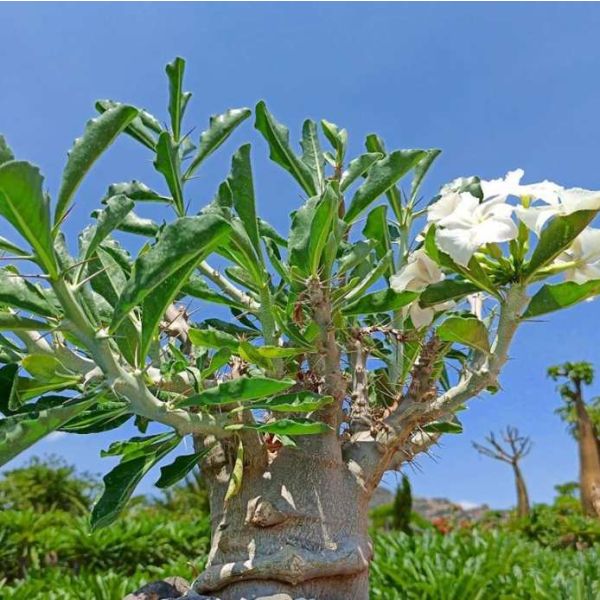Pachypodium Saundersii Seeds (Kudu Lily)
Pachypodium Saundersii Seeds (Kudu Lily)
This species grows in dry woodland amongst rocks or in rock crevices.

Delivery
All orders shipped with UPS Express.
Always free shipping for orders over US $250.
All orders are shipped with a UPS tracking number.
Returns
Items returned within 14 days of their original shipment date in same as new condition will be eligible for a full refund or store credit.
Refunds will be charged back to the original form of payment used for purchase.
Customer is responsible for shipping charges when making returns and shipping/handling fees of original purchase is non-refundable.
All sale items are final purchases.
Help
Give us a shout if you have any other questions and/or concerns.
Email: contact@domain.com
Phone: +1 (23) 456 789
Availability: In stock
SKU
Pachypodium Saundersii
Pachypodium Saundersii is native to South Africa. The main distinction of this plant is its habit of not growing straight up, but rather staying low and spreading horizontally with a multitude of arching spiny branches and a massive central caudex. One curious growth habit particular to this form and which facilitates the horizontal branching is the drying back of the main stem at some point during the first few years. This occurs during the winter dormancy and is readily noticeable when new leaves emerge in early spring. With no main growth apex, all energy is channeled to the side branches. Try this and see how different it is.
This plant makes a great potted specimen with natural 'bonsai' like growth. The long branches can be cut back to maintain a more compact form. Mature specimens can be under-potted to create a spectacular effect. Pachypodium Saundersii is probably the easiest and fastest Pachypodium to grow. It is a hardy succulent shrub that can grow up to 1.5 m high. The exposed tuberous stem is up to 1 m in diameter and produces several narrow, thorny branches. The glossy leaves are lanceolate-ovate and almost glabrous.
P. Saundersii wax-like white flowers with pinkish throat are about 3-5 cm in diameter. This plant flowers at the apex of this year's growth, usually in late summer or fall, at the end of the growing season, when it reaches 4-5 years old. The shiny white flowers occur in clusters, each flower lasting a couple of days, but the flowering time can be several weeks. They seem to need a cooler winter dormancy to bloom properly.In this family the fruits (called follicles) are produced in pairs. Each fruit may contain several dozen of seeds designed for wind dispersal.
Two significant adaptations allow Pachypodium to survive in dry, hostile environments: ?pachycaul? trunks, and spines. The thick, more or less pithy, trunks of Pachypodium facilitate water storage similar to a cactus. The trunks and branches can also photosynthesize, making the leaves, which can cause rapid water evaporation from the plant, unnecessary in times of drought. Spines help condense moisture from fog or dew into drops which fall at the base of the plant.
Hardiness Zones: 10-11 (1c/35f, 4c/40f). Pachypodium Saundersii is semi tender so protect it on coldest nights, or keep it in container. This plant prefers a sunny or light shaded position. When grown in full sun, summer watering should be ample, and rapid growth will take place in larger pots. They are strong summer growers and will usually go dormant if allowed to go below about 50 F or so. When the plant is leafless keep it dry, with only occasional water. They are not damaged until the temperatures dip into the 20's. This species grows in dry woodland amongst rocks or in rock crevices.
| Common name | Kudu Lily |
|---|---|
| Species | Pachypodium saundersii |
| Germination | Sow the Pachypodium seeds in a 5 mm deep, sterile, sandy medium (4 parts fine and 4 parts coarse river sand; 1 part sieved, well-rotten compost; 1 part perlite; 1 part vermiculite) in summer. Keep moist and at a temperature of 27?35øC to ensure rapid germination. The seedlings grow quickly compared to other Pachypodium species. After germination, transplant the seedlings into individual pots and water them regularly. Germination can take longer. Be patient! |
| Price View | Price Range |

